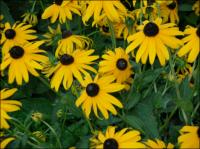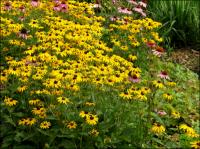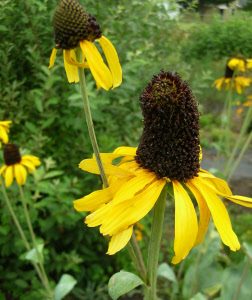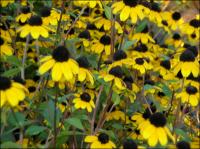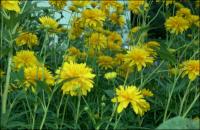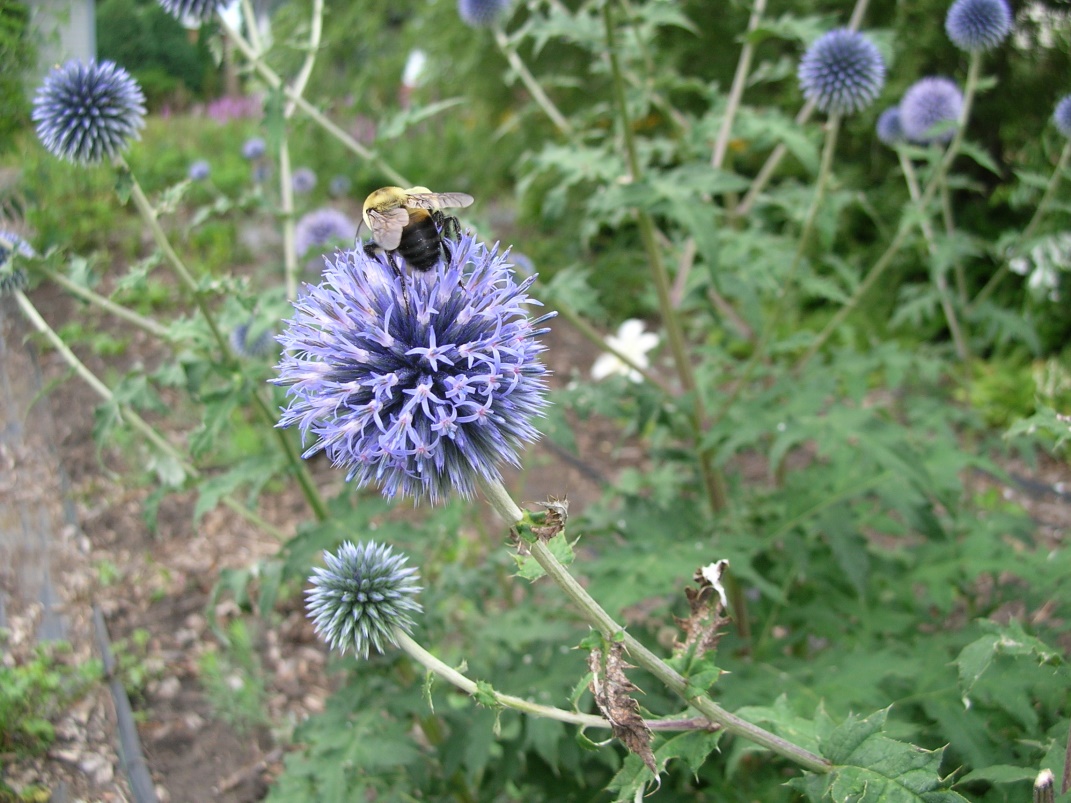…Joy Sedum x herbstsfreude Autumn oxeye, Giant daisy Chrysanthemum serotinum Autumn sun coneflower Rudbeckia nitida ‘‘Herbstonne’ Balkan moor grass Sesleria heufleriana Balloon flower Platycodon grandiflorum Balloon flower Platycodon grandiflorum…
More »Search Results for: rudbeckia
-
Rudbeckia subtomentosa ‘Henry Eilers’ Z 4-8
OUT OF STOCK These Rudbeckias tower above basal leaves on rigid, branching stems forming clumps of sun yellow petaled flowers surrounding a raised, brown dome of disc flowers. But instead...
OUT OF STOCK
These Rudbeckias tower above basal leaves on rigid, branching stems forming clumps of sun yellow petaled flowers surrounding a raised, brown dome of disc flowers. But instead of flat petals, the petals are rolled into narrow tubes, looking like many spokes of a wheel blooming from mid-summer into fall.
Size: 3-5’ x 1-2’
Care: sun in moist well-drained soil
Wildlife Value: attracts butterflies, deer resistantHenry Eilers discovered this cultivar while scouting a southern Illinois prairie. Here is his story.
Henry Eilers, born in 1934, long-time nurseryman, had introduced selections of different ornamental plants that he found growing at his nursery. But Rudbeckia subtomentosa ‘Henry Eilers’ is different. Henry worked tirelessly for decades to preserve Illinois plants and their diversity. In the early 1980’s while scouting a prairie remnant near Witt in Montgomery County IL he spied a small clump of uncommon Black-eyed susan. Instead of the usual broad, flat petals, this one has narrow, quilled petals. He dug it and replanted it at his nursery where it grew on. It still grows in his wildflower garden. He decided to name it Rudbeckia ‘Montgomery County.’ In the 1990’s Henry took it and other native wildflowers to a native plant sale at the Shaw Arboretum, Missouri Botanic Garden. He and another nurseryman, Larry Lowman exchanged a few plants, one being this Rudbeckia. Several years later he found it for sale in the Plant Delight’s Nursery catalog, renamed Rudbeckia ‘Henry Eilers.’ Over time the plant appeared in gardening magazines and mail order catalogs. It now grows in the entrance planting at the National Botanic Garden in Washington, at the Missouri Botanic Garden and the Brooklyn Botanic Garden. A nurseryman from the Czech Republic told Henry he had been growing it!
-
Rudbeckia laciniata ‘Herbstsonne’ Rudbeckia nitida ‘Herbstsonne’ syn. Rudbeckia ‘Autumn Sun’ Z 5-10
ARCHIVED Note: This is a plant not currently for sale. This is an archive page preserved for informational use. Exceptionally large & drooping petals, with a tall, central cone of...
ARCHIVED
Note: This is a plant not currently for sale. This is an archive page preserved for informational use.
Exceptionally large & drooping petals, with a tall, central cone of green, blooms July to September.
Size: 4-7’ x 2-3’
Care: sun to part shade in moist well-drained soil
Wildlife Value: provides butterfly nectar and seeds food for birds
Awards: Royal Horticultural Society Award of Garden MeritIt’s “an old selection.”
-
Rudbeckia subtomentosa Sweet coneflower Z 4-8
These Rudbeckias tower above basal leaves on rigid, branching stems forming clumps of sun yellow petaled flowers surrounding a raised, brown-purple dome of disc flowers....
These Rudbeckias tower above basal leaves on rigid, branching stems forming clumps of sun yellow petaled flowers surrounding a raised, brown-purple dome of disc flowers.
Size: 4-5' x 1-2'
Care: Sun to part shade in moist to moist well-drained soil
Native: East US, Wisconsin native.
Wildlife Value: attracts butterflies, deer resistantRudbeckia was named by Linnaeus for his University of Upsala professor, Olaf Rudbeck. Rudbeck made the surprising claim “that the Paradise of Scripture was situated somewhere in Sweden.” C.F. Level. This species described in 1815. May have been collected by English planthunter John Bradbury (1768-1823).
-
Rudbeckia fulgida Black eyed susan Z 4-9
The classic Black-eyed susan, 2-3″ wide yellow daisies with a dark center from July – October...
The classic Black-eyed susan, 2-3″ wide yellow daisies with a dark center from July – October
Size: 30" x 18"
Care: full sun to part shade in moist well-drained to well-drained soil
Native: East and Southeastern U.S.
Wildlife Value: A great number of bees, flies and beetles collect pollen or drink nectar from this RudbeckiaCherokee ate the stems and leaves and used this species to remedy earaches, sores, flux, venereal disease, snakebites, dropsy, and swelling. Iroquois healed the heart and rid children of worms with this, Potawatomi make a brown dye with this. This species fulgida was introduced to England in 1760 and named in William Aition’s Hortus Kewensis, V. 3 p. 251 (1789).
-
Rudbeckia maxima Great coneflower Z 4-9
Magnificent wildflower with huge paddle-shaped leaves of blue-grey-green and tall stalks of finch-gold petals encircling central cones 4-5″ tall....
Magnificent wildflower with huge paddle-shaped leaves of blue-grey-green and tall stalks of finch-gold petals encircling central cones 4-5″ tall.
Size: 5-6' x 2'
Care: Sun in moist to moist well-drained soil
Native: OK, AK, TX & LA
Wildlife Value: Nectar source for larvae of painted Lady butterfly & for large Wood nymph butterfly.Rudbeckia was named by Linnaeus for his University of Upsala professor, Olaf Rudbeck. Rudbeck made the surprising claim “that the Paradise of Scripture was situated somewhere in Sweden.” C.F. Leyel. This species collected by Englishman Thomas Nuttall (1786-1859) in Oklahoma Territory near the Red River in 1816. Nuttall searched much of the No. American continent from New England west to Oregon, the South, Midwest, the Plains, S.E., California & Hawaii, finding thousands of new plants.
-
Rudbeckia triloba Branched coneflower, Brown eyed susan Z 3-9
Multitudes of stems, each bearing a small sunny daisy with brown centers at its tip for a sun-drenched crowd from July to October, as cheery as they come....
Multitudes of stems, each bearing a small sunny daisy with brown centers at its tip for a sun-drenched crowd from July to October, as cheery as they come.
Size: 3-4' x 2-3'
Care: sun to part shade in moist well-drained to well-drained soil
Native: most of North America, Wisconsin native
Wildlife Value: Numerous bees, some flies, a few wasps and butterflies feed on the nectar and pollen. One bee feeds only on Rudbeckias and Ratibida flowers.
Awards: Georgia Gold Medal winner. England’s Royal Horticultural Society Award of Garden Merit.Rudbeckia was named by Linnaeus for his University of Upsala professor and founder of the Uppsala botanic Garden, and his son, University of Uppsala professor named Olaf Rudbeck. This species collected in Colonial Virginia in 1600’s.
-
Rudbeckia laciniata var. hortensia Golden Glow Z 3-9
Imposing double daisies with multiple petals bloom atop a 6 or 7 foot erect stem as thick as a small tree trunk reign over neighboring flowers like a king. “Rich,...
Imposing double daisies with multiple petals bloom atop a 6 or 7 foot erect stem as thick as a small tree trunk reign over neighboring flowers like a king. “Rich, yellow double flowers borne in autumn, excellent for cutting, “Sanders 1913. Blooms July-August.
Size: 5-7' x 12" and spreading
Care: sun in moist well-drained to well drained soil, drought tolerant
Wildlife Value: Immune to Walnut toxinsSerendipitous discovery in a group of seedlings in 1894. Said to be “the most popular hardy perennial introduced during the last 25 years,” April, 1905, The Garden magazine. Recommended by Gertrude Jekyll in 1908. Beth in New Mexico advised that her alpaca named Ricardo finds them delicious.
Best Blossoms for Bees
…Clematis paniculata Sweet autumn clematis Clematis tangutica Russian virgin bower Eupatorium coelestinum Blue mist Gaillardia aristata Blanket flower Liatris aspera Rough blazing star Lobelia siphilitica Blue cardinal flower Rudbeckia subtomentosa…
More »DEADHEAD IS NOT JUST FOR Jerry Garcia’s Sugar Magnolia.
…Tickseed, Digitalis Foxglove, Eryngium Sea holly, Geranium, Kalimeris False aster, Monarda Beebalm, Nepeta Catmint, Phlox, Platycodon Balloon flower, Rudbeckia Brown or Black eyed susan, Salvia Sage, Tradescantia Spiderwort, and Veronica…
More »


